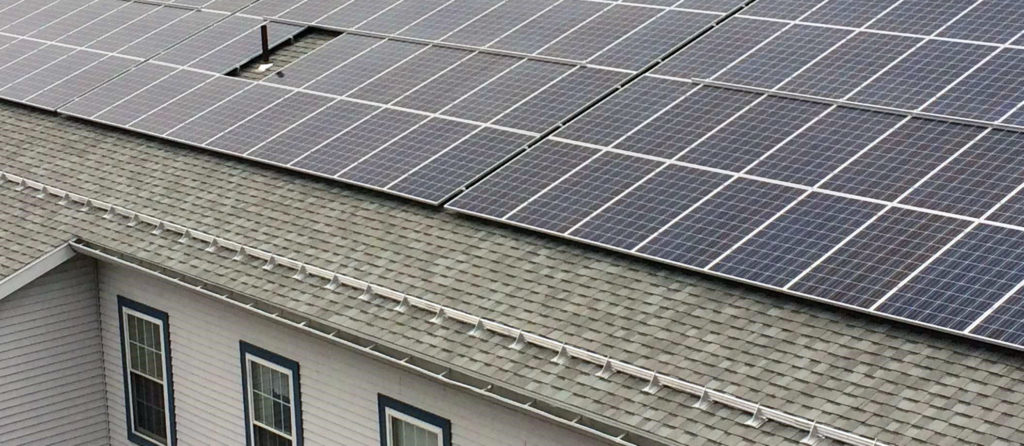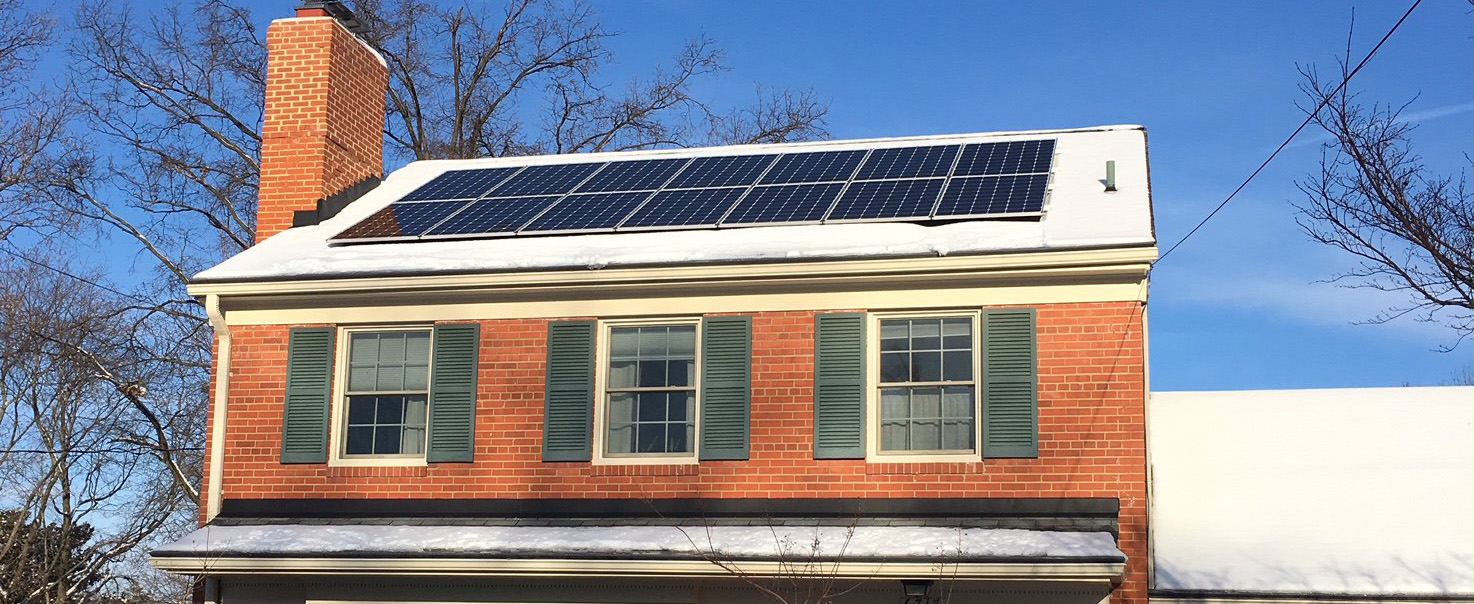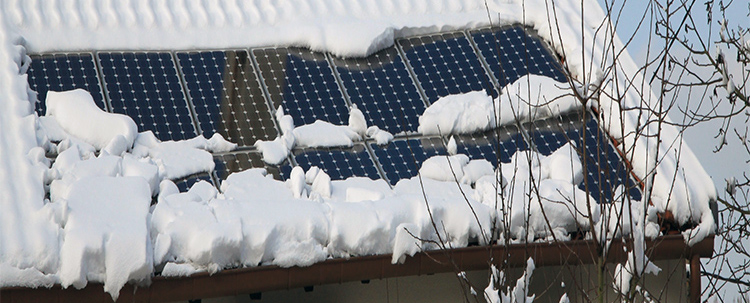Several Alpine SnowGuards’ customers reached out to us between 2010-2012 hoping we could provide solar snow management for PV arrays. This was an entirely new snow management problem that was evolving right along with the solar industry.
This new problem stemmed from solar PV arrays installed on composition shingle roofs that don’t shed “much” snow or ice. In this case, the word “much” needs clarification, as snow on solar is a widely misunderstood situation.
In the Northeastern U.S., snow tends to fall and melt over the course of a week or two. However, it’s pretty common for snowfall from multiple events to accumulate. It then remains on comp shingle roofs for weeks – even for the majority of a winter season. Eventually, these accumulations reach density and viscosity levels that allow them to shed off the roof in the form of an avalanche. A similar phenomenon occurs on cedar shingle roofing.
Homeowners with comp or cedar shingle roofs would agree they experience sliding-snow-and-ice once or twice a year. These events are less significant and less dramatic on a comp shingle roof than on a solar array installed over comp shingle. Homeowners in areas with high snow volumes, like the Rocky Mountains, are likely to experience similar situations. Sometimes they experience them with greater frequency than the events in the Northeast and East coast regions).
We approached analyzing this problem from the perspective we were most familiar with: roof-mounted snow guards.

Analyzing Solar Snow Management for PV Arrays
Based on our experience up to that point, we felt the “best practice” for managing snow on solar was to install a roof-mounted device just below the array. This required a minimum landing zone of 24” below the butt of the array.

On a typical comp shingle or cedar shingle roof, one tier of roof mounted snow guards might be enough of a barrier to manage the snow mass. However, we were now faced with a situation where the roof area to be managed was no longer comp shingle or cedar, with their high friction surfaces and water absorption properties. What we faced were solar arrays (glass, no friction) that in most cases needed added snow management devices as supplements to the roof-mounted snow guards.
Alpine Launched Solar Snow Management System in 2012
Back in 2012, Alpine launched a solar snow management system which has evolved into a three-component system. The system clamps directly to the panel frame in the vertical joint between the panels, and can be used on projects with Ground Snow Loads up to 50 psf (psf gsl).
This is where Alpine differs from most other snow guard manufacturers. We recognize that devices can be built to hold back an amount of weight, but that doesn’t necessarily translate to the amount of snow volume related to that weight. Physically, these brackets, when installed properly and in the right quantities, will resist snow loads up to 50 psf gsl. However, due to the need to prevent panel shading, these brackets and rails are limited to a maximum height of 2”. Our Solar SnowMax Shade Angle Analysis gives an overview of how we came to that conclusion.
The Solar SnowMax-Standard system (installed upslope between tiers) is 1” in height. Do some of you already foresee the problem? The brackets and bars will structurally manage the given loads, but the depth of the mass resting against a 1” and/or 2” barrier has limitations. According to NOAA’s National Severe Storms Laboratory, thirteen inches of snow equals, on average, one inch of rain in the U.S., although this ratio can vary from two inches for sleet, to nearly fifty inches for very dry, powdery snow under certain conditions.
Alpine does not believe or maintain that the use of 1” and 2” high rails on PV arrays will always manage the snow mass in steep-slope, high snow load regions, to the expectation of the building owner.
Our Latest Solar Snow Management Innovation
Alpine SnowGuards is constantly innovating and this is the latest three-component solar snow management system.
Within the roofing industry, there are snow guards that are 2” tall. They seem to manage the release of snow and ice adequately. Alpine has sold such systems since the late 1990’s. Solar panels do not behave like typical roofing products, though. As soon as a solar panel begins to collect sunlight and activate, it begins to produce heat. As this happens, snow and ice on the array begins to melt faster than the same snow and ice accumulated on adjacent roof surfaces.
The snow mass is managed in a way that it doesn’t suddenly evacuate the array, but it clears more quickly than the comp shingle roof itself, allowing the panels to produce electricity. Sounds great, and it is, but snow and ice will still slide from these arrays in varying amounts and at varying speeds, depending on variables such as roof pitch, snow load, vertical length of array, snow density, etc.

Managing Customer Expectations
The ideal system has the following qualities:
- Prevents a sudden release, avalanche, of snow
- Low-profile for aesthetic reasons and for the need to prevent shading
- Cost-effective and easy to install
- Will retrofit existing arrays
Our system does all of this, however, just like the comp shingle roof we talked about earlier, there will be times when snow and ice still come off. For the building owner who believes that snow guards will cure all problems, this is a less than expected outcome.
When Alpine first introduced solar snow management solutions, we intended for the PV frame-mounted snow guards to supplement the traditional roof-mounted snow guards. Alpine’s stance is that all solar snow management systems start with the installation of a roof-mounted snow management system installed below the butt of the array (with a minimum 24” landing zone). Even with the roof-mounted system, snow and ice will still come over the rails under certain conditions.
Solar Installer’s Responsibility
It’s the responsibility of the solar installer to plan new installations, while allowing for a roof landing zone and a roof-mounted snow management system to be supplemented by array-mounted devices. For existing arrays that do not have a landing zone, the installer should either remove panels to allow for the landing zone, or understand that the array-mounted snow guards alone are limited in height, and are therefore, also limited in function.
I hope this helps shed some light on a very important, and relatively new topic: Managing Snow on Solar.
Until next time,
Brian Stearns
President & Founder, Alpine SnowGuards
We keep snow in its place
888.766.4273
Sign up to start using our Online Project Calculator for an immediate layout and project pricing!
Subscribe to our monthly newsletter and keep up on the latest industry and Alpine news, products, and upcoming events!
Alpine SnowGuards designs, engineers, and manufactures snow management systems from our facility in Morrisville, VT. We work closely with leading roofing contractors, engineering firms, developers, solar installers and roofing manufacturers to ensure we deliver quality products that do what we say they’ll do. Alpine SnowGuards can help a building qualify for LEED® credits.


